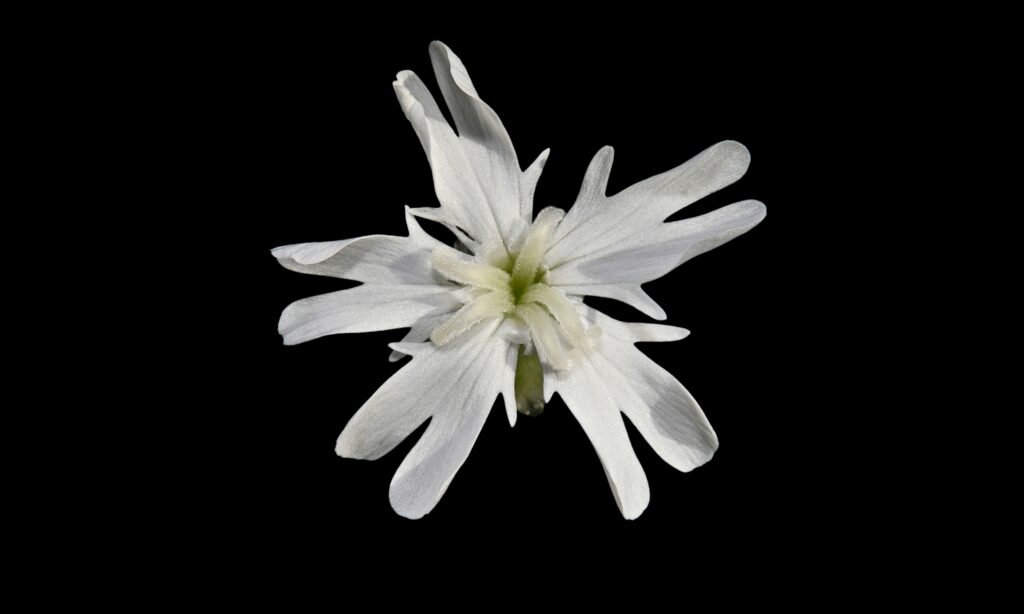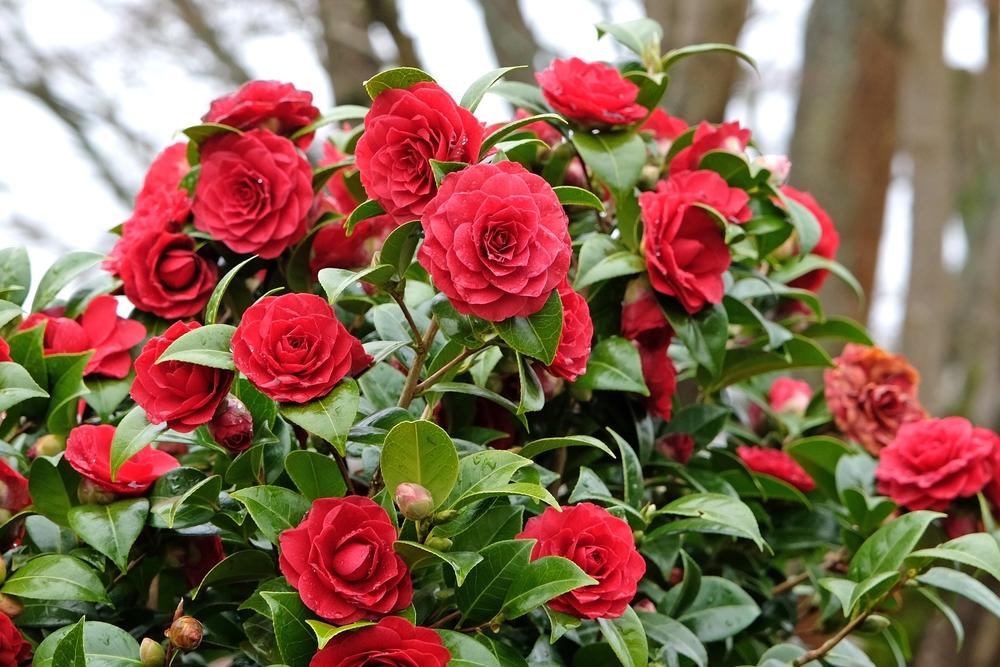Some flowers are so rare that they can only bloom under very specific environmental conditions, known as microclimates. These delicate species rely on unique combinations of temperature, humidity, soil, and sunlight to survive and thrive. From tropical rainforests to arid deserts, these blooms showcase the incredible diversity and fragility of nature. Let’s explore these rare flowers from around the world, each one adapted to a particular microclimate.
Ghost Orchid (Dendrophylax lindenii)

The Ghost Orchid, found primarily in the humid swamps of Florida and Cuba, is famous for its ethereal beauty and elusive nature. This leafless orchid thrives as an epiphyte, clinging to the trunks of trees in wet, shaded environments, where high humidity and low light provide the perfect microclimate. Its white flowers resemble a ghostly apparition, with long, curved tendrils that give it an otherworldly appearance. It is notoriously difficult to cultivate due to its reliance on mycorrhizal fungi, which help it obtain nutrients. This flower blooms in the summer, releasing a faint, apple-like fragrance. Due to habitat loss and illegal poaching, it is classified as endangered, with conservation efforts underway to protect its dwindling population.
Gibraltar Campion (Silene tomentosa)

The Gibraltar Campion is one of the rarest flowers in the world, native only to the high, rocky cliffs of Gibraltar. This hardy plant thrives in microclimates created by the rock formations, where cooler air and moisture from the Mediterranean Sea help it survive. Thought to be extinct in the wild in 1992, it was miraculously rediscovered in 1994, growing in small, isolated patches on the Rock of Gibraltar. It is well-adapted to the rocky, well-drained soils of its native habitat and blooms in the spring and summer, with conservation efforts in place to protect this critically endangered species.
Kadupul Flower (Epiphyllum oxypetalum)

The Kadupul Flower, also known as the “Queen of the Night,” is a rare cactus species native to the forests of Sri Lanka. This night-blooming flower opens only for a few hours during the late evening, releasing a sweet fragrance before wilting by dawn. It thrives in warm, humid microclimates with indirect light, often blooming during monsoon seasons when moisture levels are optimal. Its large, star-shaped white blossoms are stunning yet transient, symbolizing the fleeting beauty of nature. Despite its ephemeral nature, it is considered sacred in Sri Lankan culture. It is nearly impossible to grow outside its natural environment, as the exact conditions required for blooming are difficult to replicate. The rarity and short lifespan of its bloom make it a treasured sight among those lucky enough to witness it.
Jade Vine (Strongylodon macrobotrys)

Endemic to the tropical rainforests of the Philippines, the Jade Vine is renowned for its striking turquoise flowers that resemble claw-shaped clusters. This vine thrives in the humid, shaded ravines near riverbanks, where it can climb up to 60 feet, supported by the surrounding vegetation. Its unique color and bat-pollinated flowers make it a spectacle in its native habitat, though deforestation has significantly reduced its population. The vine’s long pendants, which can contain up to 75 individual flowers, bloom sporadically depending on moisture and temperature conditions. These are notoriously difficult to propagate, requiring the specific microclimate of their natural environment to survive. Its blossoms are a crucial food source for local wildlife, including bats and birds, further highlighting the plant’s ecological importance.
Middlemist’s Red (Camellia japonica ‘Middlemist’s Red’)

One of the rarest flowers in the world, the Middlemist’s Red Camellia exists in only two known locations: a botanical garden in New Zealand and a private garden in England. This brilliant red flower, originally native to China, thrives in temperate, sheltered microclimates with well-drained, acidic soils. Its striking crimson blooms and pointed petals make it a coveted plant, but over-collection and habitat loss have driven it to near extinction. It requires cool, humid environments with partial shade to flourish, conditions that are difficult to replicate outside its native range.
Corpse Flower (Amorphophallus titanum)

Native to the rainforests of Sumatra, the Corpse Flower is infamous for its massive size and the foul odor it emits during bloom. This colossal plant, which can grow up to 3 meters in height, thrives in the warm, humid microclimates of the rainforest floor, where it blooms sporadically—sometimes taking several years between flowerings. The odor, resembling rotting flesh, attracts carrion beetles and flies, which are essential for pollination. Its unique adaptation to its microclimate allows it to survive in nutrient-poor soils, relying on a symbiotic relationship with the fungi in its root system. Due to habitat destruction, this rare flower is now more commonly seen in botanical gardens, where it draws large crowds when it blooms.
Rothschild’s Slipper Orchid (Paphiopedilum rothschildianum)

Known as the “Gold of Kinabalu,” Rothschild’s Slipper Orchid is one of the rarest and most expensive orchids in the world. Endemic to the rainforests of Borneo, it thrives at altitudes above 1,600 feet, where the cool, moist air and well-drained soils provide the perfect growing conditions. Its long, striped petals and horizontal bloom orientation distinguish it from other orchids. However, it can take up to 15 years to bloom, adding to its rarity. Its specialized habitat is under threat due to deforestation and illegal collection, making it critically endangered. Conservationists are working to protect its remaining populations in Kinabalu National Park.
Parrot’s Beak (Lotus berthelotii)

The Parrot’s Beak is a rare flower species native to the Canary Islands, thriving in volcanic, well-drained soils with minimal rainfall. Its striking blooms resemble the beak of a parrot, with vibrant red and orange hues that stand out against the plant’s silver-blue foliage. The flower requires a microclimate with mild temperatures, partial shade, and high humidity, making its natural habitat crucial for its survival. In cooler climates, it can be grown as an annual but requires careful attention to watering and soil conditions. This perennial vine also spreads across rocky landscapes, creating a vivid display of color when in full bloom.
Juliet Rose (Rosa ‘Sweet Juliet’)

The Juliet Rose, created by famed breeder David Austin, is one of the rarest and most expensive roses in the world. Known for its deep peach and apricot blooms, it thrives in temperate climates with well-drained, fertile soil and full sun. The microclimate required for this rose includes cool nights and moderate humidity, which help maintain its intricate petal structure and vibrant color. It was developed over 15 years, making it a unique specimen in the world of roses. Due to its exclusivity, it is often sought after for weddings and high-end events. It blooms profusely during the spring and summer months, filling gardens with its sweet fragrance.
Cooke’s Kokio (Kokia cookei)

Cooke’s Kokio is an extremely rare flowering tree native to Hawaii, surviving only in controlled environments after becoming extinct in the wild. This deciduous tree requires the specific microclimate of Hawaii’s coastal dry forests, with well-drained, sandy soils and minimal rainfall. Its deep crimson flowers bloom sporadically throughout the year, adding a striking contrast to its large, green leaves. The flowers, which resemble plumes of red silk, have a short lifespan but are highly regarded for their vibrant color. The tree’s natural habitat has been devastated by deforestation and agricultural expansion, leaving only a few specimens alive in botanical gardens.
Black Bat Flower (Tacca chantrieri)

The Black Bat Flower is one of the most unusual and rare flowers, native to the tropical rainforests of Southeast Asia. It thrives in the moist, shaded understories of rainforests, where high humidity and consistent temperatures create the ideal microclimate. The flower’s large, bat-like bracts and long whisker-like filaments give it an eerie appearance, while its dark purple color adds to its mystique. It blooms during the rainy season when moisture levels are at their peak, and it requires consistently wet, well-drained soil to survive. Its pollination relies on insects, which are attracted to the flower’s dark color and musty scent.
Lady’s Slipper Orchid (Cypripedium calceolus)

The Lady’s Slipper Orchid is a rare and beautiful flower, native to temperate forests across Europe and Asia. It thrives in calcareous soils rich in organic matter, where it can form symbiotic relationships with fungi to access nutrients. It blooms in late spring, producing vibrant yellow and purple flowers that resemble a slipper, giving the plant its name. It requires a microclimate with cool temperatures, partial shade, and moist, well-drained soils to survive. Deforestation and illegal collection have decimated its natural populations, leading to its protection in many countries. Efforts are now being made to reintroduce the plant into the wild through careful cultivation.
Fire Lily (Gloriosa superba)

The Fire Lily, also known as the Flame Lily, is native to tropical regions of Africa and Asia, where it thrives in forested and grassland areas. This climbing plant blooms in the summer, producing vibrant red and yellow flowers that resemble flames. It requires a warm, humid microclimate with well-drained soils, often blooming after seasonal rains. The plant is highly toxic, with all parts containing compounds that can be harmful to humans and animals if ingested. Despite its toxicity, it is widely cultivated as an ornamental plant due to its striking beauty. It also plays a role in traditional medicine in some cultures but must be handled with care due to its poisonous nature.
This article originally appeared on Rarest.org.
More from Rarest.org
15 Forgotten Luxury Cars That Faded Into Obscurity

Luxury cars once held as the epitome of design and prestige have not all remained in the spotlight. Many models that once dazzled with opulence and innovation have since slipped into obscurity. Read More.
15 Incredible Plants That Thrive in Extreme Deserts

Deserts are known for their harsh environments, but they are home to some of the most resilient and fascinating plants. These plants have adapted to extreme conditions like scorching heat, limited water, and nutrient-poor soils. Read More.
19 Ancient Reptiles That Have Survived Through Millennia

Some reptiles have existed for millions of years, surviving drastic environmental changes. These ancient species carry a rich history and have adapted to endure through millennia. Read More.
